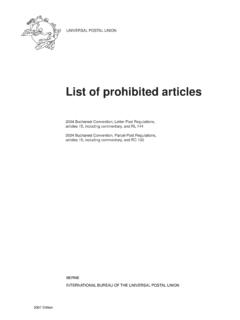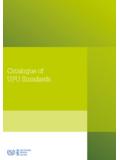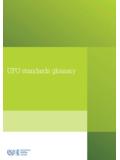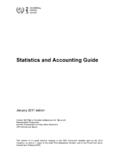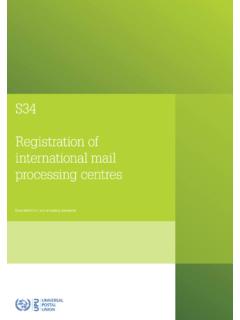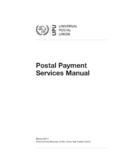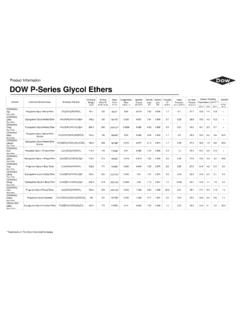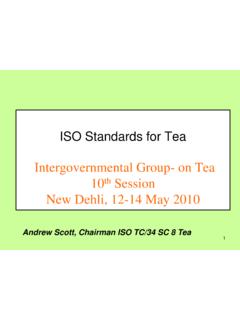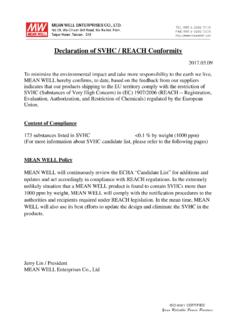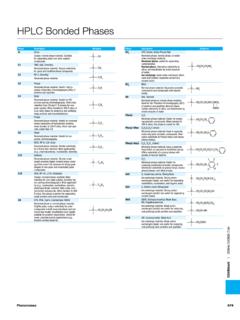Transcription of List of Psychotropic Substances under …
1 (E) *1053991* Green List international Narcotics control Board List of Psychotropic Substances under international ControlIn accordance with the Convention on Psychotropic Substances of 1971(24th edition, May 2010)Annex to the annual statistical report on Psychotropic Substances (form P) 2 The Green List has been prepared by the international Narcotics control Board to assist Governments in completing the annual statistical report on Psychotropic Substances (form P) and the quarterly statistics of imports and exports of Substances in Schedule II of the Convention on Psychotropic Substances of 1971 (form A/P). For information on the names used for Substances under international control and preparations containing such Substances , as well as on chemical and structural formulae and other technical information, see Multilingual Dictionary of Narcotic Drugs and Psychotropic Substances under international Green List is divided into four parts: Part one.
2 Substances in Schedules I, II, III and IV of the Convention on Psychotropic Substances of 1971; Part , synonyms and trade names of Psychotropic Substances , their salts and preparations containing Psychotropic Substances under international control ; Part three. Pure drug content of bases and salts of Psychotropic Substances under international control ;Part four. Prohibition of and restrictions on export and import pursuant to article 13 of the Convention on Psychotropic Substances of 1971. _____1 United Nations publication, Sales No. The frequent introduction of new preparations of Psychotropic Substances and the withdrawal of old ones by the pharmaceutical industry makes the updating of the present Green List necessary for the effectiveness of controls. In pursuit of this objective, the international Narcotics control Board (INCB) maintains a database containing a list of such preparations.
3 Governments are kindly requested to notify INCB of any additions, deletions or amendments that should be made to the present list. 3 Part one. Substances in Schedules I, II, III and IV of the Convention on Psychotropic Substances of 1971 Psychotropic Substances under international control are presented in the schedules below. Where an international non-proprietary name (INN) is available for a substance , that INN is given in the left-hand column. Where no INN is available, the non-proprietary or trivial names of the substance are given in the second column of the table. Where a trivial name is commonly applied to a substance with a given INN, then the trivial name is also given in the second column. Salts of all the Substances covered by the four schedules, whenever the existence of such salts is possible, are also under international control .
4 The following interpretation guidelines2 concerning the stereoisomers of Substances in Schedules II, III and IV of the 1971 Convention3 were developed, pursuant to Commission on Narcotic Drugs decision 42/2, in order to clarify the scope of control of stereoisomers of Substances in those schedules: (a) When the substance listed can exist as stereochemical variants the following should apply: (i) If the chemical designation of the substance used in the 1971 Convention (or in a subsequent scheduling decision of the Commission on Narcotic Drugs does not include any stereochemical descriptors or indicates a racemic form of the substance : a. If the molecule contains one chiral centre, both the R- and S-enantiomers and the RS-racemate are controlled, unless specifically excepted by a decision of the Commission on Narcotic Drugs; b.)
5 If the molecule contains more than one chiral centre, all the diastereoisomers and their racemic pairs are controlled, unless specifically excepted by a decision of the Commission on Narcotic Drugs; (ii) If the chemical designation used in the 1971 Convention (or in a subsequent scheduling decision of the Commission on Narcotic Drugs) for the substance which contains one chiral centre in the molecule includes a stereochemical descriptor indicating a specific enantiomer, the racemic form of the substance is also controlled, unless specifically excepted by a decision of the Commission on Narcotic Drugs, while the other enantiomer is not controlled; (iii) If the chemical designation used in the 1971 Convention (or in a subsequent scheduling decision of the Commission on Narcotic Drugs) for the substance which contains more than one chiral centre in the molecule includes stereochemical descriptors indicating a specific diastereoisomer, only that diastereoisomer is controlled; (b) When one enantiomer is controlled, then a mixture of that enantiomer with the other enantiomeric substance is controlled; (c) The chemical designations and INNs used in the scheduling decisions to define Substances in Schedules II, III and IV of the 1971 Convention were considered appropriate at the times when such decisions were made.
6 It should be understood that: (i) Alternative chemical designations constructed according to modified chemical nomenclature rules may be used in official documents as long as they preserve the stereospecificity when appropriate; (ii) If any subsequent modification of an INN definition uses a chemical designation which is different to that in the scheduling decision, such an INN should be omitted from official documents. In order to facilitate rapid identification of all scheduled Psychotropic Substances , CAS (Chemical Abstracts Service) registry numbers were included for the most traded Substances (Schedule II, III and IV Substances ) and their salts. The list is not exhaustive and the absence of a CAS number does not mean that it does not exist but rather that it was not available at the time of the update of the list.
7 CAS numbers were included in the following cases:_____2 The guidelines are also applicable to the stereoisomers of Substances in Schedule I, whenever the existence of such stereoisomers is possible within the specific chemical designation, which are under international control unless specifically excepted by a decision of the Commission on Narcotic Drugs. 3 WHO Expert Committee on Drug Dependence: Thirty-second Report, WHO Technical Report Series No. 903 (Geneva, World Health Organization, 2001), annex. 4(i)The substance under international control exists in the base form and stereoisomer variants do not exist, , it is a unique CAS number. (ii)If stereoisomers exist within the specific chemical designation: if stereoisomers and racemic mixture are already listed and related CAS numbers are available (example: amphetamine, dexamfetamine and levamfetamine). 5 Substances in Schedule I IDS codes international non-proprietary nameOther non-proprietary or trivial namesChemical namePD 009 BROLAMFETAMINE DOB ( )-4-bromo-2,5-dimethoxy- -methylphenethylamine PC 010 CATHINONE ( )-(S)-2-aminopropiophenone PD 001 DET 3-[2-(diethylamino)ethyl]indole PD 007 DMA ( )-2,5-dimethoxy- -methylphenethylamine PD 003 DMHP 3-(1,2-dimethylheptyl)-7,8,9,10-tetrahyd ro-6,6,9-trimethyl-6H-dibenzo[b,d]pyran- 1-ol PD 004 DMT 3-[2-(dimethylamino)ethyl]indole PD 008 DOET ( )-4-ethyl-2,5-dimethoxy- -methylphenethylamine PP 003 ETICYCLIDINE PCE N-ethyl-1-phenylcyclohexylamine PE 006 ETRYPTAMINE 3-(2-aminobutyl)indole PN 005 N-hydroxy MDA ( )-N[ -methyl-3,4-(methylenedioxy)phenethyl]hy droxylamine PL 002 (+)-LYSERGIDE LSD, LSD-25 9,10-didehydro-N,N-diethyl-6-methylergol ine-8 -carboxamide PN 004 MDE, N-ethyl MDA ( )-N-ethyl- -methyl-3,4-(methylenedioxy)phenethylami ne PM 011 MDMA ( )
8 -N, -dimethyl-3,4-(methylenedioxy)phenethyla mine PM 004 mescaline 3,4,5-trimethoxyphenethylamine PM 019 methcathinone 2-(methylamino)-1-phenylpropan-1-one PM 017 4-methylaminorex ( )-cis-2-amino-4-methyl-5-phenyl-2-oxazol ine PM 013 MMDA 5-methoxy- -methyl-3,4-(methylenedioxy)phenethylami ne PM 020 4-MTA -methyl-4-methylthiophenethylamine PP 001 parahexyl 3-hexyl-7,8,9,10-tetrahydro-6,6,9-trimet hyl-6H-dibenzo[b,d]pyran-1-ol PP 017 PMA p-methoxy- -methylphenethylamine PP 012 psilocine, psilotsin 3-[2-(dimethylamino)ethyl]indol-4-ol PP 013 PSILOCYBINE 3-[2-(dimethylamino)ethyl]indol-4-yl dihydrogen phosphate PP 007 ROLICYCLIDINE PHP, PCPY 1-(1-phenylcyclohexyl)pyrrolidine PS 002 STP, DOM 2,5-dimethoxy- ,4-dimethylphenethylamine PM 014 TENAMFETAMINE MDA -methyl-3,4-(methylenedioxy)phenethylami ne PT 001 TENOCYCLIDINE TCP 1-[1-(2-thienyl)cyclohexyl]piperidine PT 002 tetrahydrocannabinol, the following isomers and their stereochemical variants.
9 7,8,9,10-tetrahydro-6,6,9-trimethyl-3-pe ntyl-6H-dibenzo[b,d]pyran-1-ol (9R,10aR)-8,9,10,10a-tetrahydro-6,6,9-tr imethyl-3-pentyl-6H-dibenzo[b,d]pyran-1- ol (6aR,9R,10aR)-6a,9,10,10a-tetrahydro-6,6 ,9-trimethyl-3-pentyl-6H- dibenzo[b,d]pyran-1-ol (6aR,10aR)-6a,7,10,10a-tetrahydro-6,6,9- trimethyl-3-pentyl-6H-dibenzo[b,d]pyran- 1-ol 6a,7,8,9-tetrahydro-6,6,9-trimethyl-3-pe ntyl-6H-dibenzo[b,d]pyran-1-ol (6aR,10aR)-6a,7,8,9,10,10a-hexahydro-6,6 -dimethyl-9-methylene3- pentyl-6H-dibenzo[b,d]pyran-1-ol PT 006 TMA ( )-3,4,5-trimethoxy- -methylphenethylamine The stereoisomers of Substances in Schedule I are also controlled, unless specifically excepted, whenever the existence of suchstereoisomers is possible within the specific chemical in Schedule IIIDS Codes CAS Number international non-proprietary nameOther non-proprietary or trivial namesChemical namePA 003 300-62-9 AMFETAMINE amphetamine ( )- -methylphenethylamine PA 007 57574-09-1 AMINEPTINE 7-[(10,11-dihydro-5H-dibenzo[a,d]cyclohe pten-5-yl)amino]heptanoic acid PB 008 66142-81-2 2 C-B 4-bromo-2,5-dimethoxyphenethylamine PD 002 51-64-9 DEXAMFETAMINE dexamphetamine (+)
10 - -methylphenethylamine PD 010 DRONABINOL adelta-9-tetrahydro-cannabinol and its stereochemical variants (6aR,10aR)-6a,7,8,10a-tetrahydro-6,6,9-t rimethyl-3-pentyl-6H-dibenzo [b,d]pyran-1-ol PF 005 3736-08-1 FENETYLLINE 7-[2-[( -methylphenethyl)amino]ethyl]theophyllin e PL 006 156-34-3 LEVAMFETAMINE levamphetamine ( )-(R)- -methylphenethylamine(amphetamine (-)isomer PL 007 33817-09-3 levomethamphetamine ( )-N, -dimethylphenethylamine PM 002 340-57-8 MECLOQUALONE 3-(o-chlorophenyl)-2-methyl-4(3H)-quinaz olinonePM 005 537-46-2 METAMFETAMINE methamphetamine (+)-(S)-N, -dimethylphenethylamine PM 015 7632-10-2 METAMFETAMINE RACEMATE methamphetamine racemate ( )-N, -dimethylphenethylamine PM 006 72-44-6 METHAQUALONE 2-methyl-3-o-tolyl-4(3H)-quinazolinone PM 007 113-45-1 METHYLPHENIDATE methyl -phenyl-2-piperidine acetate PP 005 77-10-1 PHENCYCLIDINE PCP 1-(1-phenylcyclohexyl)piperidine PP 006 134-496 PHENMETRAZINE 3-methyl-2-phenylmorpholine PS 001 76-73-3 SECOBARBITAL 5-allyl-5-(1-methylbutyl)barbituric acid PZ 001 34758-83-3 ZIPEPROL -( -methoxybenzyl)-4-( -methoxyphenethyl)-1-piperazineethanol aThis international non-proprietary name refers to only one of the stereochemical variants of delta-9-tetrahydrocannabinol, namely (-))

